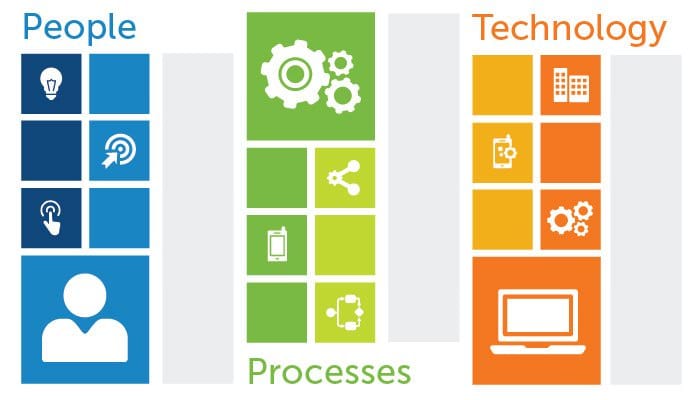People, not technology are still the key determinant of success.
Technology is constantly changing the way we live. From self-driving cars and omnipresent chatbots to automated marketing tools, it sometimes feels like humans are being edged out by our robotic overlords instead of fulfilling "the promise that technology allows humans to be better humans."
At least we still have the market cornered on artistic pursuits, right? Sort of.
The music world was shaken up when researchers at Sony’s Computer Science Laboratory managed to create two original songs using software known as Flow Machines. The programs analyzed a massive database of existing music and then churned out two tunes based on detected patterns. The first song, “Daddy’s Car,” sounds a bit like an uninspired Beatles track.
While technophiles around the world celebrated it as a landmark moment for artificial intelligence, they ignored one glaring aspect of the project: A French musician wrote the lyrics and produced the tracks.
What does this prove? Technology is a resource capable of solving various dilemmas, but it isn’t a cure-all. Without a “people” component overseeing cutting-edge technology, it can easily fall flat.
Consider the incredible growth of marketing technology, a booming industry featuring thousands of exciting platforms, programs, and apps. Since 2011, the martech landscape has grown by nearly 2,300 percent. That’s not a typo. This explosion of new tools has caused businesses to fundamentally shift their marketing approaches. It’s almost enough to make you long for the days of billboards and direct mail.
The digital marketing era has forced companies to adjust to a world where technology has shifted from “nice to have” to “need to have.” SalesForce, Oracle, and other startups streamlined marketing without requiring organizations to build their own solutions while building your own "best of breed" marketing cloud, which has started to gain popularity. Marketing stacks have evolved from a few relatively simple tools to a litany of tech solutions expected to work in tandem.
But don’t be lulled into thinking these countless martech options will solve all of your problems. Behind every successful digital marketing venture are innovative, forward-looking, flexible creatures who make the entire system work: human beings.
Technology’s Fuel: People Power
At every level, people must be involved for technology to succeed. A consistent lack of that human element can ruin even the most promising tech, as corporate giants Microsoft and Cigna discovered.

Microsoft made an embarrassing gaffe in the chatbot world with Tay, an artificial intelligence program the company released in 2016. Tay was designed to learn young people’s lingo by combing Twitter, Kik, and GroupMe. The goal? Tay would become completely integrated into Millennial culture. The outcome? Disaster.
Instead of an upbeat, friendly chatbot, Tay took a turn for the dour. In the span of a single day, Tay became a hate-spewing monster because it failed to understand the nuances of human communication. Microsoft swiftly shut down Tay for “adjustments,” though the chatbot never resurfaced. It was an embarrassment for a corporation so widely regarded for its technology prowess.
Cigna made a similar misstep when it tried to retool its front-end and back-end processes through a massive data migration. The company pictured a seamless flow of customer information across the company, with real-time data enhancing customer experiences. The actual result was more of a nightmare.
Cigna employees (and customers) lost access to what they needed when they needed it. And instead of improving productivity and raising customer trust, Cigna dealt with a tanked reputation and lost nearly $400 million. Cigna forgot that technology solutions act as support, not as strategy.
People cannot rely on technology as a panacea. Martech investments can provide incredible results, but companies must account for the human element. At one end, you have the Cigna example, and at the other, you have social autoresponders. We cannot account for everything, nor can the developers and engineers of the products they create.
Finding the Human Side of Technology
Should we stop relying on technology and avert our eyes? Absolutely not. Even if we wanted to, it would be impossible. Instead, we should view technology as a tool rather than a full-blown remedy. Above all else, we must know how to ensure humans are part of the equation. To paraphrase Jay Baer, “Tools are great, but...success is about the wizard, not the wand.”
1. Find the gaps and fill them.
People crave meaning. As evidenced by the Tay example or the bizarre bot-penned holiday tune of late 2016, machines aren't quite capable of making that connection. Humans are dynamic and nuanced, whereas machines can only act based on past interactions. Perpetually looking in the rearview mirror makes it difficult for machines to anticipate the highly organic and unpredictable nature of people.
Social autofollow and autorespond services are great examples of martech gone wrong. Every automated Twitter response I’ve received feels disingenuous, self-promotional, and bot-generated, even though I'm sure that's not the intention. Still, I’m inclined to unfollow by default. As appealing as automation is, the risk of making the recipients feel like they aren't worth your time is too high.
But this doesn't mean you cannot automate and still maintain a sense of your humanity.
I recently missed a deadline for an email due to illness. Instead of sending the intended email before I got sick, I used the opportunity to come clean. I wrote a more personal message admitting I blew it and missed the deadline.
The results were revealing. I didn't try to pawn the email off as a personal message to each person, but many of the recipients responded as though I had. I was blown away by their well wishes and understanding — as well as the positive response to why I had sent the email.
2. Focus on human resources early and often.
Consider marketing automation and content personalization. Both solutions require one key ingredient: content.
If content is the connective tissue between our business and customers, leveraging technology such as marketing automation and content personalization to support it requires strategy, creation, production, and marketing. These tools simply don't work without content and the resources associated with it.
The earlier you know the people necessary to make your marketing stack work, the more prepared you’ll be to shift gears or make course alterations when necessary. Regularly set aside time to look for missed opportunities from having too few people wear too many hats.
3. Prioritize strategy at all stages.
Given the large investment required for most technology — not to mention unintended mishaps from not knowing why, what, or how you're going to use it — it’s impossible to underscore the value of strategic thinking.
Robert Rose, chief content advisor at the Content Marketing Institute, puts it best: “Thinking strategically costs you nothing.” A strategic approach will save you time in evaluating solutions, identifying resources, and executing your plan.
Man and machine have always had a complicated relationship. Man can function — albeit less effectively — without machines, but machines can never reach their full potential without man. Faster, smarter, and better tech tools are assets, but they don’t always know how to intuitively adjust and adapt. By ensuring there’s a human element to any technology your company adopts, you can set yourself up for success rather than costly growing pains.

Thanks to
Sean Schroeder for sharing their advice and opinions in this post.
Sean Schroeder is the CCO of
Blue River and co-founder of the
Mura Experience Platform. A former graphic designer and front-end developer, Sean is a self-confessed app junkie currently consumed with creating content-driven experiences that help businesses attract and create their ideal customer.




 Thanks to
Thanks to 



